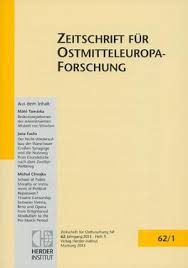„Diejenigen, welche Brüder entzweien“. Über die Anfänge politischer Organisation orthodoxer Juden in der Zweiten Polnischen Republik
‘Those Who Cause Strife between Brothers’: The Beginnings of Political Organization among Orthodox Jews in the Second Polish Republic
Author(s): Daniel MahlaSubject(s): Jewish studies, Political history, Nationalism Studies
Published by: Verlag Herder-Institut
Keywords: nationalism; Jewish Orthodoxy; Second Polish Republic; political movements; relational history; Jewish politics;
Summary/Abstract: Grappling with the social and political upheavals sweeping the continent and torn by fierce struggles over the future of Jewish communal organization, Europe’s Orthodox Jews began to mobilize politically in the late 19th and early 20th centuries. Over the course of these decades, two organizations emerged that would soon become the foremost Orthodox movements in Europe and Palestine: the religious Zionist movement Mizrahi, founded 1902 in Vilna, and the non-Zionist Agudat Yisrael (Agudah), founded 1912 in the city of Kattowitz. Not long after their founding, both Mizrahi and Agudat Yisrael had established multiple branches throughout Europe and Palestine and had proven themselves influential players in the arena of Jewish politics. In the interwar period, the Second Polish Republic became the two movements’ foremost battleground. To garner the support of Orthodox Jews, both movements were active in local Jewish communities, sent delegates to the Polish Sejm and engaged in polemics and mutual struggles on the pages of their party organs. In the early post-war years, local offices and branches were set up in Warsaw as well as in numerous other cities and shtetls across Poland. Soon, both organizations had enjoyed wide support among Orthodox Jews, established their own schooling systems and rabbinical seminars, founded youth groups and separate workers’ organizations. The article investigates the significance of political and ideological competition between the two Orthodox movements during the early years of the Second Republic with a special focus on their regional development. While the influence of German-Jewish leaders on the establishment of the Polish Agudat Yisrael has received some scholarly attention, Agudat’s relations with the religious Zionists have been largely neglected. Yet, as this article argues, mutual competition was of decisive importance for the formation and organizational development of the two Orthodox movements in the early post-war years. Competing for the same constituencies, both parties used their struggles to develop and sharpen their party ideologies and to attract mass support.
Journal: Zeitschrift für Ostmitteleuropa-Forschung
- Issue Year: 66/2017
- Issue No: 1
- Page Range: 41-69
- Page Count: 29
- Language: German

